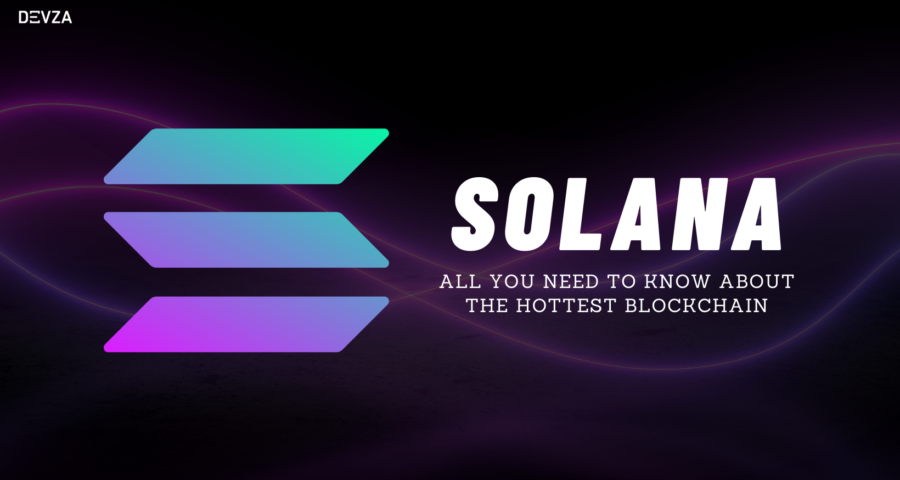What is Solana?
Solana is the fastest blockchain in the world, dedicated to solving the blockchain trilemma. It’s a programmable blockchain that enables decentralized applications, or DApps. Launched in 2020, it has achieved a market cap of about $29 billion.
Solana was founded by Anatoly Yakovenko, Greg Fitzgerald, Raj Gokal, Stephen Akridge, and Zed Zed. Backed by A16z and Polychain, it is obtainable on several major cryptocurrency exchanges. Notably, it is also backwards compatible with Ethereum.
It is currently ranking among the top 10 cryptocurrencies in the world.
What is the blockchain trilemma?
No blockchain (yet) has been able to be at once scalable, secure, and decentralised. Thus, a popular belief was born that public blockchains must sacrifice either scalability, security, or decentralization.
For instance, Bitcoin is decentralised and secure, but can only transact 5 transactions per second. To counter this, it is developing the second scaling layer, the Lightning Network.
How does Solana try to solve the blockchain trilemma?
Solana utilizes a combination of proof of stake consensus and proof of history to solve the blockchain trilemma.
Proof of history is Anatoly Yakovenko’s main innovation. Solana has created a synchronized clock that allocates a timestamp to each transaction. Proof of History is a way to decrease the time spent validating the order of transactions. Utilized with Proof of Stake, this eases the selection of the next validator.
This removes the ability of bots and miners to control the order in which transactions appear on the blockchain. This enhances security and censorship resistance, and also supports its scaling up performance up to 65,000 TPS.
Put together, this results in scalability, without compromising on security or decentralization. Hence, Solana claims to have solved the blockchain trilemma.
What are Solana’s key features?
Solana’s key features are:
- Proof of History (PoH) – a clock before consensus. In effect, a synchronized clock for each node. It stores historical records of events, therefore building efficiency.
- Tower BFT – a PoH-optimized version of PBFT. A consensus algorithm that employs PoH.
- Turbine – a block propagation protocol. It breaks data down, easing data transfer, resulting in better transaction speed.
- Gulf Stream – Mempool-less transaction forwarding protocol.
- Sealevel – Parallel smart contracts run-time.
- Pipelining – a Transaction Processing Unit for validation optimization. It assigns a stream of input to different hardware for processing.
- Cloudbreak – Horizontally-Scaled Accounts Database. It organizes the database, and makes parallel reads and writes.
- Archivers – Distributed ledger storage.
How does Solana work?
The Proof of Stake consensus model is reinforced by Tower BFT (Byzantine Fault Tolerance).
Tower BFT uses Solana’s PoH as a clock before consensus, lowering the amount of messaging among nodes, thus improving the transaction speed. This creates a permanent reference of events and transactions for the nodes.
Tower BFT also decreases the processing power required for transactions, as timestamps of previous transactions no longer need to be processed. This boosts Solana’s throughput.
Sealevel is Solana’s parallelized transaction processing engine. This permits simultaneous transactions on the same chain, allowing for a better runtime. This also enables parallel smart contract runtime.
The mempool-less transaction forwarding protocol, Gulf Stream, is the reason for Solana’s high TPS. This protocol caches transactions and forwards them to the edge of the network.
This cuts down on confirmation time and validator memory requirements from unconfirmed transaction pools. On account of network validators having the ability to execute transactions early, before the previous set is finalized.
This is a unique feature, and maximises transaction confirmation speed, and the concurrent and parallel transaction capacity of the network.
What is Solana’s native token?
Solana’s native token is $SOL. As of now, it is trading at US $101.239 per token (as of August 30th, 2021 | 11:15 | UTC). There is a maximum supply of 502.9 million coins. Currently, 290.9 million are in circulation. It uses the SPL protocol.
SOL is Solana’s utility token. It is used to pay transaction fees when making transfers, during interaction with smart contracts, and making micropayments, referred to as lamports within the ecosystem. DApps are also conceiving new use cases for it.
SOL transaction fees are permanently destroyed, or ‘burnt’, as a part of Solana’s deflationary model.
By staking a minimum of 0.01 SOL, SOL token holders can become validators, in exchange for more SOL coins.
As a part of the blockchains PoS (Proof of Stake) mechanism, SOL token holders can also stake their tokens with validators. If successful, the validators share some reward with the stakers.
In conclusion?
Solana’s network hosts several amazing projects and partnerships, such as Serum, USDC, and Metaplex. Audius chose to migrate to Solana from Ethereum. There are over 400 projects in the ecosystem, displaying the fact that more developers are beginning to build on it, due to its low transaction fees and latency.
Experts refer to Solana as the first truly web scalable blockchain in the world, owing to its high TPS. It is by far the most performant blockchain network, an accomplishment without using off-chain or layer-2 protocols.
There is a strong case for it rising to rival Bitcoin and Ethereum one day.


Leave a Reply